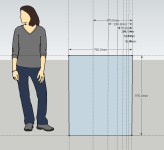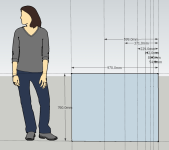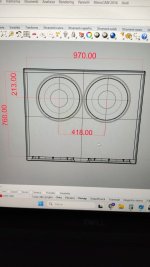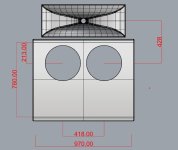Hello diyer,
I would like to ask you for help on the positioning of the woofers with respect to the front baffle.
In particular, I am interested in the positioning with respect to the y-axis.
With a net height of 76cm, the first fundamental wave occurs at about 225hz.
To minimize the vertical standing waves, if I understood correctly, the woofer should be positioned between 1/4 and 3/4 of the height or between 1/3 and 2/3 of the height (acting a little less on the fundamental and a little more on the harmonics).
What is, if there is, the ideal compromise between the management of the standing waves and the minimization of the frontal lobing?
Thanks in advance to everyone.
I would like to ask you for help on the positioning of the woofers with respect to the front baffle.
In particular, I am interested in the positioning with respect to the y-axis.
With a net height of 76cm, the first fundamental wave occurs at about 225hz.
To minimize the vertical standing waves, if I understood correctly, the woofer should be positioned between 1/4 and 3/4 of the height or between 1/3 and 2/3 of the height (acting a little less on the fundamental and a little more on the harmonics).
What is, if there is, the ideal compromise between the management of the standing waves and the minimization of the frontal lobing?
Thanks in advance to everyone.
Attachments
For actual frequency response and less cancelation, mount woofer as shown, as close as possible to each of for
tight center to center.
In a box or rectangle the longest area is the " uh oh" region. That gets fixed with absorption material.
For offset no distance should be equal. Which helps with diffraction
Golden ratio or something close often used. for cabinet shape and driver placement towards one edge. Technically
it is 1.618. But for all the goobers that like to argue or people who simplify.
1:6 ratio or rounded up often falls closer to 1:7 so any magical division or science you want to make up close to 1:6 to 1:7 ratio
is good enough.
You can also subtract 1:6 divisions to get different shapes, the Greeks were pretty good at it.
tight center to center.
In a box or rectangle the longest area is the " uh oh" region. That gets fixed with absorption material.
For offset no distance should be equal. Which helps with diffraction
Golden ratio or something close often used. for cabinet shape and driver placement towards one edge. Technically
it is 1.618. But for all the goobers that like to argue or people who simplify.
1:6 ratio or rounded up often falls closer to 1:7 so any magical division or science you want to make up close to 1:6 to 1:7 ratio
is good enough.
You can also subtract 1:6 divisions to get different shapes, the Greeks were pretty good at it.
Since your 760mm wide or tall, whatever the orientation
Simplified golden ratio with no decimal points can be divided to
1260
*760 *
470
290
179
111
69
42

Next upward is 1260 rather tall and can subtract smaller values for more ideal height/tall
whatever orientation
1218
1191
1149
1081
* 970*
500
So your 970 dimension is a rather good choice actually
970
599
371
229
142
88
54

Simplified golden ratio with no decimal points can be divided to
1260
*760 *
470
290
179
111
69
42

Next upward is 1260 rather tall and can subtract smaller values for more ideal height/tall
whatever orientation
1218
1191
1149
1081
* 970*
500
So your 970 dimension is a rather good choice actually
970
599
371
229
142
88
54

Last edited:
Your application is important to know..?
I guess you mean pulling the woofers away from the range above them. It is manageable, though often spoken about critically.. but you'd have to develop the cross in the acoustic sense to see where you're at.
For this you would need to know whether you will try to avoid the region or need to play through it. Woofers in the middle raises the frequency of the first.(acting a little less on the fundamental and a little more on the harmonics)
What frontal lobing?between the management of the standing waves and the minimization of the frontal lobing?
I guess you mean pulling the woofers away from the range above them. It is manageable, though often spoken about critically.. but you'd have to develop the cross in the acoustic sense to see where you're at.
To minimize the vertical standing waves, if I understood correctly, the woofer should be positioned between 1/4 and 3/4 of the height or between 1/3 and 2/3 of the height (acting a little less on the fundamental and a little more on the harmonics).
What is, if there is, the ideal compromise between the management of the standing waves and the minimization of the frontal lobing?
To minimise internal standing waves one adds stuffing to the inside of the cabinet where the particle velocity is highest (i.e. in the middle rather than at the walls). The rule of thumb for stuffing to be effective is that it needs to be quarter of a wavelength thick which is usually straightforward to achieve. The placement of the woofers on the baffle is normally best determined by how they interact with cabinet geometry and the boundaries of the room which in turn is determined by how the speaker is intended to work.
Thank you for the suggestions.
I attach another image to better clarify the final use context.
Above there is an iwata horn with a 2" driver.
I would like to create the crossover between iwata and woofers between 500 and 600hz.
I asked about lobing because I would like to position the woofers for the best possible integration between the bass and midrange (iwata horn).
The final result will also depend on the mechanical alignment on the Z axis of the horn and the slope and type of filter between bass and midrange, but at the moment I am interested in understanding, given the size of the bass cabinet, where it is best to open the holes for the two woofers, to obtain the best possible compromise between the management of internal resonances and the overall frontal response.
I attach another image to better clarify the final use context.
Above there is an iwata horn with a 2" driver.
I would like to create the crossover between iwata and woofers between 500 and 600hz.
I asked about lobing because I would like to position the woofers for the best possible integration between the bass and midrange (iwata horn).
The final result will also depend on the mechanical alignment on the Z axis of the horn and the slope and type of filter between bass and midrange, but at the moment I am interested in understanding, given the size of the bass cabinet, where it is best to open the holes for the two woofers, to obtain the best possible compromise between the management of internal resonances and the overall frontal response.
Attachments
That Iwata is quite short vertically. It won't do much holding below maybe 1.5kHz, is that less important than lobing in your case?
Placed horizontally, the wavelength of the center to center distance between the woofers is ~825Hz.I would like to create the crossover between iwata and woofers between 500 and 600hz.
I asked about lobing because I would like to position the woofers for the best possible integration between the bass and midrange (iwata horn).
To prevent off axis horizontal lobing/comb filtering, the drivers should be within ~1/4 wavelength, which could be achieved if the crossover was lowered to ~206Hz.
Obviously, that crossover frequency is too low for your high frequency horn/driver.
Having made the mistake of placing 15" woofers side by side below a HF horn in monitors with a crossover in the 500-600Hz range, and hearing the resultant terrible off axis response in the crossover region, I'd say from experience that compromise far overwhelms the minimal differences internal resonances make from speaker positioning.The final result will also depend on the mechanical alignment on the Z axis of the horn and the slope and type of filter between bass and midrange, but at the moment I am interested in understanding, given the size of the bass cabinet, where it is best to open the holes for the two woofers, to obtain the best possible compromise between the management of internal resonances and the overall frontal response.
A vertical woofer/HF arrangement is far preferable.
I prefer the midway point between the upper woofer's center and the horn driver to be at or above ear height, rotating the woofer cabinet seems to be near that.
Art
That Iwata is quite short vertically. It won't do much holding below maybe 1.5kHz, is that less important than lobing in your case?
Can I ask you if you explain it to me in a different way?, I didn't understand well, thanks
The bass cabinet was originally turned with the 76cm side as depth.
We tried to divide the chambers, tilt the rear wall internally, we tried to change woofers with others with parameters adaptable to the available internal volumes, but in the end the sound was terrible, very confused.
I agree that the wavelength determined by the distance of the two woofers is 825Hz, causing the first nulling at half frequency around 410hz.
But does this also concern the iteration between woofer and horn?
The distance between the woofers and the horn, whether horizontal or vertical, does not remain more or less the same?
I intend in any case to filter the woofers separately, making only one of the two rise to cross with the horn.
You are concerned because lobing will change the directivity at the cross. To reduce lobing, you are using a short vertical horn so it will be close to the woofer.if you explain it to me in a different way?
The short horn will change the directivity above the cross. It will happen at higher frequencies where we are more sensitive.
The Augspurger monitor and TAD TSM1 are similar layouts to OP's design.Having made the mistake of placing 15" woofers side by side below a HF horn in monitors with a crossover in the 500-600Hz range, and hearing the resultant terrible off axis response in the crossover region, I'd say from experience that compromise far overwhelms the minimal differences internal resonances make from speaker positioning.
Haven't heard them myself but would these not suffer from the off axis issues described above?
No idea where the Augspurger is crossed but the TAD TSM1 appears to be crossed at 650Hz.
Yes, they would, if both woofers are crossing at the same frequency, and the horizontal center to center distance is much more than ~1/4 wavelength at the crossover frequency.The Augspurger monitor and TAD TSM1 are similar layouts to OP's design.
Haven't heard them myself but would these not suffer from the off axis issues described above?
That said, they may sound excellent on axis, where they are usually pointed at the engineer's position, and the off axis cancellation may reduce some sidewall reflections..
So, if I understand correctly, with the woofers side by side we will have horizontal lobing problems between them, while positioned vertically I imagine that the problems are vertical?
I think that in both cases we must also consider the iteration with the horn, as well as between them.
The thing that interests me most is that by transforming the current depth of the box (it is NOT that of the drawing, in the drawing it the height) into height or width the sound improves, for now it is very far from something good.
I think that in both cases we must also consider the iteration with the horn, as well as between them.
The thing that interests me most is that by transforming the current depth of the box (it is NOT that of the drawing, in the drawing it the height) into height or width the sound improves, for now it is very far from something good.
The fix for this design is the addition of a single mid driver, keeping the woofers side by side and down at the ground plane......reduced floor bounce
Crowe did an interesting experiment with side by side woofers and the actual in room results were quite successful with unintended benefits
A single 8-10" mid driver covering 300-800 hz would be ideal IMO.
Crowe did an interesting experiment with side by side woofers and the actual in room results were quite successful with unintended benefits
A single 8-10" mid driver covering 300-800 hz would be ideal IMO.
Yes.So, if I understand correctly, with the woofers side by side we will have horizontal lobing problems between them, while positioned vertically I imagine that the problems are vertical?
Vertical problems are generally not as much an issue as horizontal, as the angle variations from one side of a couch to the other would be greater than from seated to standing.
Also, our hearing is more sensitive to horizontal variations than vertical because of our laterally placed ears.
Many monitors built with horizontal woofers use 2.5 way crossovers, the outer woofer low passed at a lower frequency to reduce the lobing issues.
That said, my preference would be a vertical woofer 2.5 way rather than a horizontal in most listening situations.
Art
Thanks for all the suggestions,
in your opinion does it make sense to try to transform the old height (47cm) into width or height?
My doubt is that it was the old depth (76cm) that caused most of the problems in terms of sound quality.
A question... in the possible vertical position of the two woofers, in the case in which they are not filtered differently, so let's say simply placed in series or parallel, does it not worsen the lobing between the woofer (below) and the horn?
I think because the woofer below is further away from the horn, compared to the case of the two side by side.
in your opinion does it make sense to try to transform the old height (47cm) into width or height?
My doubt is that it was the old depth (76cm) that caused most of the problems in terms of sound quality.
A question... in the possible vertical position of the two woofers, in the case in which they are not filtered differently, so let's say simply placed in series or parallel, does it not worsen the lobing between the woofer (below) and the horn?
I think because the woofer below is further away from the horn, compared to the case of the two side by side.
In my opinion, using the same internal volume, the internal resonance variation from different cabinet aspect ratios is not a cause of most of the problems in terms of sound quality.in your opinion does it make sense to try to transform the old height (47cm) into width or height?
My doubt is that it was the old depth (76cm) that caused most of the problems in terms of sound quality.
Yes, but the vertical lobes limited to the crossover overlap region are not as much of a problem as horizontal lobing between the woofers which extends through and below the crossover overlap region.A question... in the possible vertical position of the two woofers, in the case in which they are not filtered differently, so let's say simply placed in series or parallel, does it not worsen the lobing between the woofer (below) and the horn?
Given the choice of the two evils, mine is to put the polar problems in the vertical, and design the crossover for smooth on-axis response at the midway point between the upper woofer's center and the horn driver in the far field.
In any case, without seeing measurements, hard to guess what the cause of the "terrible, very confused" sound your speakers produce..
Art
This attached is the old design, if it is not a problem of orientation / proportions of the cabinet, on which aspect do you think I should focus?
It seemed like an important aspect to take into consideration because doing some simulations with Hornresp, I noticed an increase in resonances, while increasing the depth.
As I mentioned, even dividing the chambers no improvement.
Currently the cabinet has 343 liters available, so about 170 per woofer.
Tests were carried out both with a pair of JBL 2226H and with a pair of Faital 15FH520.
Further tests were carried out until reaching a net volume of 140L per speaker, but there were no particular benefits.
Different behaviors, but the sound remained confused.
For example when in the song by Adele - Rolling in the Deep, let's say the bass line starts, I have that feeling of confused sound.
What types of measurements can be useful to try to understand?
I have a DATS V2 instrument and a microphone for acoustic measurements with SW REW.
Thanks in advance for any suggestions.
It seemed like an important aspect to take into consideration because doing some simulations with Hornresp, I noticed an increase in resonances, while increasing the depth.
As I mentioned, even dividing the chambers no improvement.
Currently the cabinet has 343 liters available, so about 170 per woofer.
Tests were carried out both with a pair of JBL 2226H and with a pair of Faital 15FH520.
Further tests were carried out until reaching a net volume of 140L per speaker, but there were no particular benefits.
Different behaviors, but the sound remained confused.
For example when in the song by Adele - Rolling in the Deep, let's say the bass line starts, I have that feeling of confused sound.
What types of measurements can be useful to try to understand?
I have a DATS V2 instrument and a microphone for acoustic measurements with SW REW.
Thanks in advance for any suggestions.
Attachments
- Home
- Loudspeakers
- Multi-Way
- woofer positioning in the cabinet

